Our story
100 years in the making

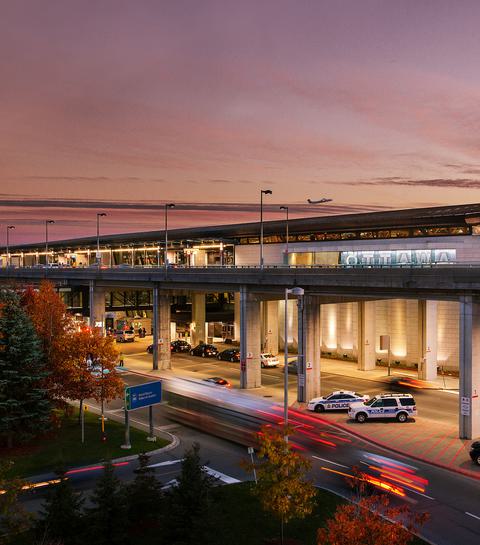
How it started
The beginning (1920s-1930s)
The first powered flight over Ottawa occurred in 1911, but a landing field wasn't established at what is now the Ottawa International Airport until the 1920s.
Initially known as Hunt Club Field, the site quickly gained significance in aviation history.
In July 1927, as Canada celebrated its Diamond Jubilee of Confederation, Charles Lindbergh arrived in Ottawa in the Spirit of St. Louis (Ryan N-X-211) at the invitation of Prime Minister William Lyon Mackenzie King. Lindbergh, accompanied by a 12-aircraft escort, landed at the Hunt Club Field, which was subsequently renamed Lindbergh Field to honour this landmark visit. Tragically, during the landing, Lieutenant Thad Johnson, one of the escort pilots, was killed when the propeller of another aircraft struck his plane's tail. Although Johnson parachuted from his plane, he was too close to the ground for his parachute to fully deploy, leading to his death. In his memory, an Airport roadway was renamed Thad Johnson Private.
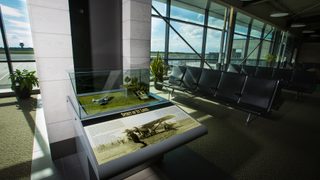
The Ottawa Flying Club was incorporated on January 14, 1928, and by July 26, 1928, it had been granted the first airport license, prompting another renaming of the airfield to Uplands Aerodrome.
In November 1936, the federal government formed the Ministry of Transport, led by C.D. Howe. Tasked with enhancing connectivity across Canada and the British Commonwealth, Minister Howe initiated the creation of Trans-Canada Airlines in April 1937. The success of this airline depended on the establishment of a reliable cross-country air service, which necessitated suitable landing fields along the route. The Ottawa Flying Club, unable to finance the required upgrades to the landing strip, eventually abandoned the site. In a fortunate turn of events, Laurentian Air Services, one of Canada's pioneering bush-flying companies, bought the airfield in 1937 and undertook necessary improvements, including the construction of a hangar and other facilities. The Ottawa Flying Club resumed operations under a new, extended lease.
Despite these efforts, the demands of supporting Trans-Canada Airlines proved too great, leading the Department of Transport to purchase the 300-acre aerodrome from Laurentian Air. The Department swiftly embarked on upgrading the site, including the construction of new facilities and two hard-surfaced runways. On August 20, 1938, Transport Minister Howe inaugurated the newly renamed Uplands Airport.
With the onset of World War II, the Department of National Defence acquired the airport and established its own facilities. Uplands was converted into a Service Flying Training School for the Royal Canadian Air Force (RCAF), and additional land to the east was acquired for the construction of five hangars and a military camp.

Military years (1940s)
On August 1, 1940, the British Commonwealth Air Training Plan School opened at Uplands Airport. During World War II, the skies were dominated by RCAF Harvards and other training aircraft, as many pilots earned their wings and went on to serve in Europe.
Even after the war ended, Uplands continued to play a crucial military role. With Canada’s commitment to the North Atlantic Treaty Organization (NATO), Ottawa emerged as a key base for international flights.
Civil aviation takes off (1950s)
By the end of 1951, Uplands Airport had commissioned runways 14/32 and 07/25, measuring 8,800 and 6,200 feet respectively. The 412 Squadron of the RCAF, a notable military unit based at Uplands, was instrumental in transporting important dignitaries to Ottawa.
By the late 1950s, the combined military and civilian traffic at Uplands made it the busiest airport in Canada, with a remarkable 307,079 aircraft movements recorded in 1959 alone.
Catering to growing civilian travel (1960s - 1980s)
Construction of a new airport terminal began in 1957 under the Department of Transport. However, the project faced a setback when a U.S. Air Force F-104 Starfighter broke the sound barrier, shattering nearly every window in the nearly completed structure and causing significant damage. This incident extended the construction timeline by approximately one year and increased the budget by $300,000, bringing the total to $5 million. The terminal was finally inaugurated by Prime Minister John Diefenbaker on June 30, 1960.
Designed by local architects Gilleland and Strutt, the terminal was built to handle up to 900,000 passengers annually. To accommodate growing air traffic, the two main runways were extended in 1961: 14/32 to 10,000 feet and 07/25 to 8,000 feet.
On August 24, 1964, the Airport was officially renamed Ottawa International Airport.
By 1980, YOW was serving approximately 2 million passengers annually, which was more than double its designed capacity. A major renovation plan was announced in 1982 and completed in 1986.
The control tower and radar services were relocated to the Combined Air Navigation Facility and Regional Training Centre on Limebank Road in 1991.
In June 1993, the federal government renamed the airport Ottawa Macdonald-Cartier International in honor of two of Canada’s Fathers of Confederation.
Over to the community (1990s)
In the early 1990s, the federal government introduced the National Airports Policy to create a system of safe, efficient, and effective airports. Officially launched in 1994, this policy established local airport authorities across the country, transitioning the federal role from owner/operator to owner/landlord.
On February 1, 1997, the Ottawa Macdonald-Cartier International Airport Authority (OMCIAA) was formed, with a 14-member community-based Board of Directors responsible for overseeing Airport management. Commonly known as the Ottawa International Airport Authority (OIAA or the Authority), it is part of the 26-airport National Airports System.
New millennium, new governance - new and improved YOW
Meeting travel demands and modernizing facilities (2000s-2010s)
The Authority's first major initiative was the construction of the U.S. Customs and Immigration (now U.S. Customs and Border Protection) preclearance facility, which allows passengers to clear customs in Ottawa rather than at destination.
Another early project, the Hendrick Building, was completed in 2000. Originally called the Combined Services Building, it is home to the Airport Fire Service and vehicle fleet maintenance operations. Strategically located between the runways, it ensures compliance with the mandatory airside response time for emergency vehicles.
Work also began to reimagine the Ottawa International Airport, more commonly known now as YOW, with a new, state-of-the-art passenger terminal building and covered parking facility.
On October 13, 2003, the Airport Authority opened the beautiful, new 61,000 m2 terminal and adjoined Parkade, marking the largest private construction project in Ottawa in nearly 20 years. The Parkade has since been expanded twice. Phase 2 of the terminal expansion was completed in 2008, adding 7,000 m2 more space.
The terminal features a three-level water feature that represents the bodies of water that form the landscape in Canada’s Capital Region.
On Level 3 (pre-security)
The Inukshuk, comissioned by First Air (Canadian North) and built by Inuit Elder Peter Katorka and Commissioner of Nunavut Peter Irniq, using stones collected from various communities in Nunavut. The traditional design has 'travel' as its theme, as the Inuit would look through the hole in the centre of the structure for direction. The inukshuk located on Level 3 points towards the runway used by north bound aircraft. The water surrounding it represents the Chaudière Falls.
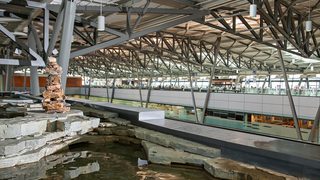
On Level 2 (post-security)
The authentic Algonquin birch bark canoe, built by master craftsman and Algonquin Elder Peter Maranda, is one of two identical canoes built in 1971. The other was chosen by the Liberal Party of Canada as a wedding gift for Prime Minister Trudeau, an experienced canoeist who paddled many of Canada's great rivers. The water surrounding the canoe represents the Rideau Canal and it is adjacent to the representation of the Rideau Falls.
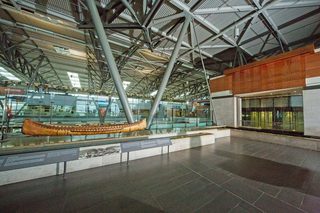
On Level 1 (pre-security)
The names of the Rideau canal system lockstations that connect Lake Ontario with the Ottawa River are displayed on the wall along the escalators leading down to the Arrivals area, culminating with a representation of the final Ottawa Lock in the system.
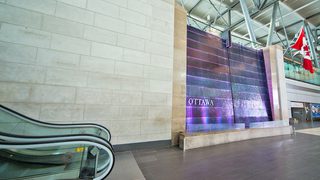
Over the years, the Authority has continued to invest in major projects that have enhanced both the safety and security of the Airport. Additionally, it continues to adopt new technologies to make passenger processing more efficient and implement more accessible features to ensure a barrier-free journey for all.
From 2011 to 2014, a comprehensive three-phase project rebuilt and rehabilitated runways 04/22, 07/25, and 14/32. The project included new lighting, surface work, installation of Runway End Safety Areas (RESAs) on both commercial runways, and replacement of electrical wiring and NAV CANADA’s Instrument Landing System (ILS) for Runway 07/25. During this multi-year project, YOW became the first major commercial airport in Canada to groove its runways which is proven to enhance drainage, increase runway friction, and mitigate aircraft hydroplaning for greater safety.
Continued growth and evolution
The following represents some of the major projects and accomplishments in the years since the Airport Authority was formed:
- Countless Airport Service Quality awards and recognition for outstanding customer service, including first in the world for our size category;
- The YOW+ terminal enhancement program launched in 2019:
- Concessions revitalization program;
- Pre-board screening checkpoint move and CATSA Plus introduction;
- LRT Airport Station construction;
- ALT Hotel construction (scheduled for completion in 2025);
- “Accessibility Certified Gold” rating by the Rick Hansen Foundation;
- Membership in the Aviation Information Sharing and Analysis Centre (Aviation ISAC) to help protect global aviation businesses, operations and services through cyberthreat intelligence and information sharing;
- Drone detection and mitigation technology trial in partnership with NAV CANADA, QinetiQ Canada, and Indro Robotics;
- Member of the Blue Ribbon Task Force on Unmanned Aerial System (UAS) Mitigation at airports;
- Founding member of the Government of Canada’s Net-Zero Challenge;
- Published inaugural Environment, Social, Governance (ESG) Report to communicate YOW’s commitment to sustainable growth, reducing our environmental footprint, improving our social responsibility, and operating with integrity and transparency through a robust governance structure;
- Completed and published first Accessibility Plan;
- Joined the Sunflower Lanyard Program to support travellers with hidden disabilities;
- Constructed new Taxiway Romeo (R) in the south airfield, unlocking new airside development potential;
- YOW became a maintenance and crew base for Porter Airlines with the construction of two maintenance hangars;
- Named a hub in Porter Airlines’ network and a vital partner in the airline’s growth plans;
- Level 3+ (Neutrality) of the Airport Carbon Accreditation Program;
- New cargo facility announced for Canadian North;
- Start of transition to electric vehicles and installation of charging stations;
- CATSA Verified Traveller Program; and
- The launch of the Authority’s new Purpose Statement.
